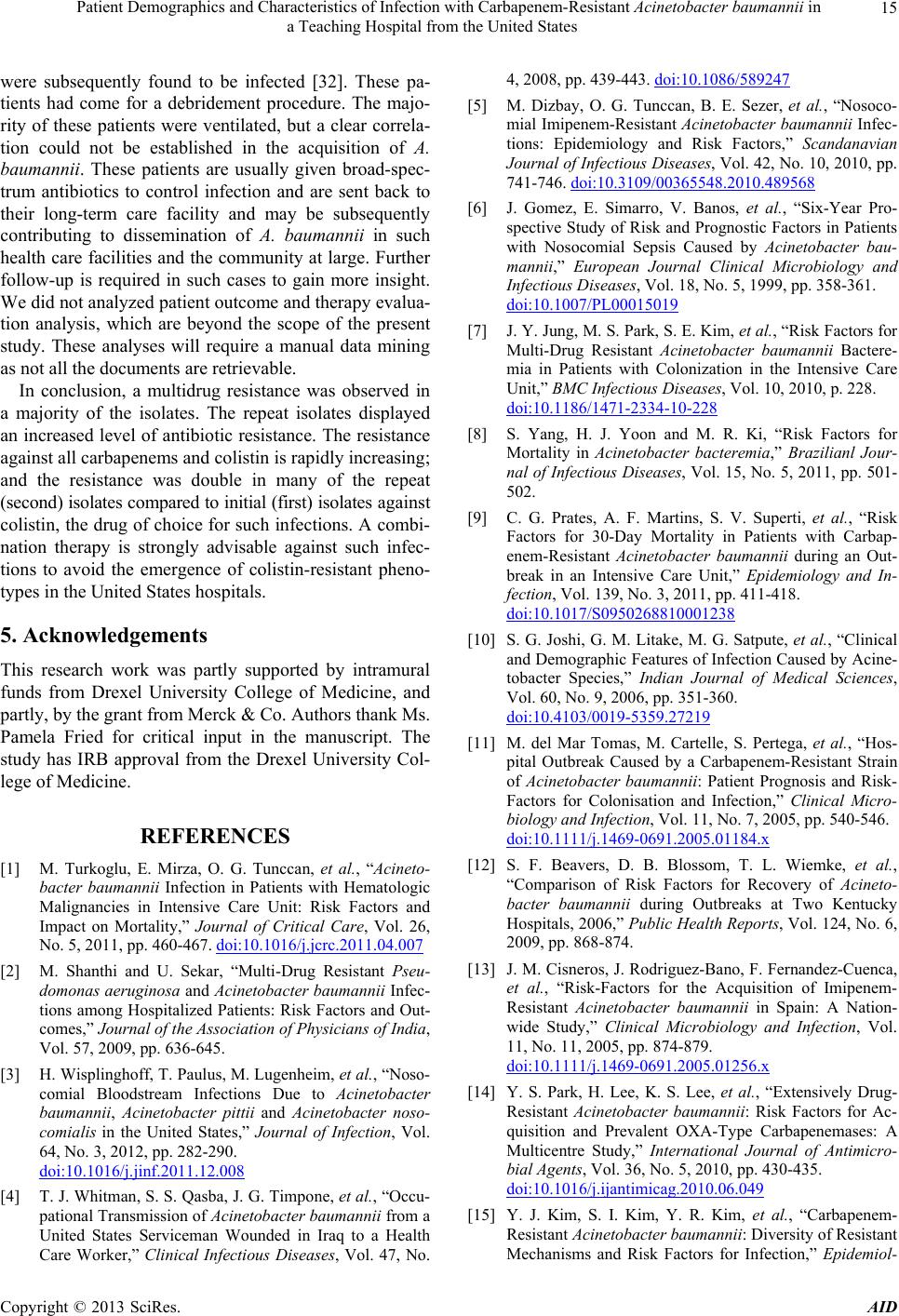
Patient Demographics and Characteristics of Infection with Carbapenem-Resistant Acinetobacter baumannii in
a Teaching Hospital from the United States
15
were subsequently found to be infected [32]. These pa-
tients had come for a debridement procedure. The majo-
rity of these patients were ventilated, but a clear correla-
tion could not be established in the acquisition of A.
baumannii. These patients are usually given broad-spec-
trum antibiotics to control infection and are sent back to
their long-term care facility and may be subsequently
contributing to dissemination of A. baumannii in such
health care facilities and the community at large. Further
follow-up is required in such cases to gain more insight.
We did not analyzed patient outcome and therapy evalua-
tion analysis, which are beyond the scope of the present
study. These analyses will require a manual data mining
as not all the documents are retrievable.
In conclusion, a multidrug resistance was observed in
a majority of the isolates. The repeat isolates displayed
an increased level of antibiotic resistance. The resistance
against all carbapenems and colistin is rapidly increasing;
and the resistance was double in many of the repeat
(second) isolates compared to initial (first) isolates against
colistin, the drug of choice for such infections. A combi-
nation therapy is strongly advisable against such infec-
tions to avoid the emergence of colistin-resistant pheno-
types in the United States hospitals.
5. Acknowledgements
This research work was partly supported by intramural
funds from Drexel University College of Medicine, and
partly, by the grant from Merck & Co. Authors thank Ms.
Pamela Fried for critical input in the manuscript. The
study has IRB approval from the Drexel University Col-
lege of Medicine.
REFERENCES
[1] M. Turkoglu, E. Mirza, O. G. Tunccan, et al., “Acineto-
bacter baumannii Infection in Patients with Hematologic
Malignancies in Intensive Care Unit: Risk Factors and
Impact on Mortality,” Journal of Critical Care, Vol. 26,
No. 5, 2011, pp. 460-467. doi:10.1016/j.jcrc.2011.04.007
[2] M. Shanthi and U. Sekar, “Multi-Drug Resistant Pseu-
domonas aeruginosa and Acinetobacter baumannii Infec-
tions among Hospitalized Patients: Risk Factors and Out-
comes,” Journal of the Association of Physicians of India,
Vol. 57, 2009, pp. 636-645.
[3] H. Wisplinghoff, T. Paulus, M. Lugenheim, et al., “Noso-
comial Bloodstream Infections Due to Acinetobacter
baumannii, Acinetobacter pittii and Acinetobacter noso-
comialis in the United States,” Journal of Infection, Vol.
64, No. 3, 2012, pp. 282-290.
doi:10.1016/j.jinf.2011.12.008
[4] T. J. Whitman, S. S. Qasba, J. G. Timpone, et al., “Occu-
pational Transmission of Acinetobacter baumannii from a
United States Serviceman Wounded in Iraq to a Health
Care Worker,” Clinical Infectious Diseases, Vol. 47, No.
4, 2008, pp. 439-443. doi:10.1086/589247
[5] M. Dizbay, O. G. Tunccan, B. E. Sezer, et al., “Nosoco-
mial Imipenem-Resistant Acinetobacter baumannii Infec-
tions: Epidemiology and Risk Factors,” Scandanavian
Journal of Infectious Diseases, Vol. 42, No. 10, 2010, pp.
741-746. doi:10.3109/00365548.2010.489568
[6] J. Gomez, E. Simarro, V. Banos, et al., “Six-Year Pro-
spective Study of Risk and Prognostic Factors in Patients
with Nosocomial Sepsis Caused by Acinetobacter bau-
mannii,” European Journal Clinical Microbiology and
Infectious Diseases, Vol. 18, No. 5, 1999, pp. 358-361.
doi:10.1007/PL00015019
[7] J. Y. Jung, M. S. Park, S. E. Kim, et al., “Risk Factors for
Multi-Drug Resistant Acinetobacter baumannii Bactere-
mia in Patients with Colonization in the Intensive Care
Unit,” BMC Infectious Diseases, Vol. 10, 2010, p. 228.
doi:10.1186/1471-2334-10-228
[8] S. Yang, H. J. Yoon and M. R. Ki, “Risk Factors for
Mortality in Acinetobacter bacteremia,” Brazilianl Jour-
nal of Infectious Diseases, Vol. 15, No. 5, 2011, pp. 501-
502.
[9] C. G. Prates, A. F. Martins, S. V. Superti, et al., “Risk
Factors for 30-Day Mortality in Patients with Carbap-
enem-Resistant Acinetobacter baumannii during an Out-
break in an Intensive Care Unit,” Epidemiology and In-
fection, Vol. 139, No. 3, 2011, pp. 411-418.
doi:10.1017/S0950268810001238
[10] S. G. Joshi, G. M. Litake, M. G. Satpute, et al., “Clinical
and Demographic Features of Infection Caused by Acine-
tobacter Species,” Indian Journal of Medical Sciences,
Vol. 60, No. 9, 2006, pp. 351-360.
doi:10.4103/0019-5359.27219
[11] M. del Mar Tomas, M. Cartelle, S. Pertega, et al., “Hos-
pital Outbreak Caused by a Carbapenem-Resistant Strain
of Acinetobacter baumannii: Patient Prognosis and Risk-
Factors for Colonisation and Infection,” Clinical Micro-
biology and Infection, Vol. 11, No. 7, 2005, pp. 540-546.
doi:10.1111/j.1469-0691.2005.01184.x
[12] S. F. Beavers, D. B. Blossom, T. L. Wiemke, et al.,
“Comparison of Risk Factors for Recovery of Acineto-
bacter baumannii during Outbreaks at Two Kentucky
Hospitals, 2006,” Public Health Reports, Vol. 124, No. 6,
2009, pp. 868-874.
[13] J. M. Cisneros, J. Rodriguez-Bano, F. Fernandez-Cuenca,
et al., “Risk-Factors for the Acquisition of Imipenem-
Resistant Acinetobacter baumannii in Spain: A Nation-
wide Study,” Clinical Microbiology and Infection, Vol.
11, No. 11, 2005, pp. 874-879.
doi:10.1111/j.1469-0691.2005.01256.x
[14] Y. S. Park, H. Lee, K. S. Lee, et al., “Extensively Drug-
Resistant Acinetobacter baumannii: Risk Factors for Ac-
quisition and Prevalent OXA-Type Carbapenemases: A
Multicentre Study,” International Journal of Antimicro-
bial Agents, Vol. 36, No. 5, 2010, pp. 430-435.
doi:10.1016/j.ijantimicag.2010.06.049
[15] Y. J. Kim, S. I. Kim, Y. R. Kim, et al., “Carbapenem-
Resistant Acinetobacter baumannii: Diversity of Resistant
Mechanisms and Risk Factors for Infection,” Epidemiol-
Copyright © 2013 SciRes. AID